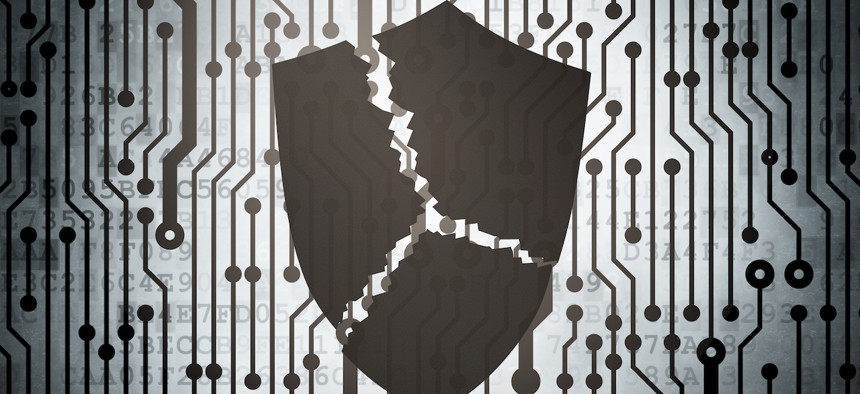A government shutdown is a catalyst event that can increase the possibility of insider threat incidents
COMMENTARY | As another government shutdown looms it’s a reminder that risks happen when you’re least prepared, writes one observer.
September is National Insider Threat Awareness Month , an annual event held since 2019 and spearheaded by the National Counterintelligence and Security Center and anchored by events hosted by the Defense Counterintelligence and Security Agency. The month brings together new ideas and thought leadership from the government agencies and the private sector, highlighting the intersection of the many stakeholders involved in protecting classified information.
Insider threats are the risks that an agency “insider” will use their position, access, or authority to do harm, whether malicious or unintentional. One of the key dialogues in insider risk conversations is man versus machine – in what ways can insider risk be addressed by technology and the growing number of continuous vetting and employee monitoring solutions – and in what ways does the conversation need to be focused on human resources and the human element of identifying risk.
As the government gears up for another potential shutdown – a catalyst event that increases the possibility of insider threat incidents – it’s a reminder that insider risks don’t just happen in one bucket, but operate at the intersection of human psychology and response and technological risk. A furloughed government worker isn’t just more likely to face financial hardships triggering a temptation to put classified programs at risk (human), but the cyber infrastructure is also more at risk (machine) if cyber workers are put on furlough or left with skinny staffs to protect networks.
There is perhaps no more ironic event to capstone a month dedicated to addressing insider risk than dealing with the looming possibility of a government shutdown – as the uncertainty continues, how agencies and organizations educate and engage their employees is a critical element of reducing the risk of an insider threat incident. At the same time, proper technological tools and resources need to be applied to the workforce to be able to monitor employee activity – to know if Employee A really needs to be downloading all of those files.
The bad news – the cycle of continuing resolutions and government shutdowns is a tale as old as time. The good news – addressing insider risk no longer involves just hoping your employees are making the right choices in the face of stress.
The Rise of the Machine – The Technology of Insider Risk
A 2018 Ponemon Institute study noted the average cost of an insider threat incident across industries was $8.76 million. That puts the rise of insider risk management tools – a growing sector for both national security and private sector employees – into perspective. It’s much easier to address an issue before it happens – and cheaper.
“Companies are increasingly aware of how employee actions both past and present can reflect on how organizations look in the public domain,” said Andrew Razumovsky, principal at CANDA Solutions, a personnel security and risk management company. “There has been an evolution in the technology. Ten years ago was really the first time when we heard continuous vetting – this was a pretty foreign concept. But today certainly in sectors like defense, government, and critical infrastructure, everybody understands how crucial it is.”
Continuous vetting is just one example of the technology that was nonexistent a decade ago and is virtually ubiquitous across government employers – at least if you have a security clearance. And as the Trusted Workforce 2.0 program rolls out across the entire public trust population, virtually anyone working for or in government will be a part of the continuous evaluation program. The technology will be there to trigger alerts, but there is still a critical human element in understanding and addressing the risks.
Like almost every big question in government, addressing insider risk is a “both/and.” That applies to the balance between technology enablement and cultural engagement. And that also applies to who is ultimately responsible for addressing and identifying risks. Government contractors can sometimes see it as a problem “for the government” – which could potentially become more prevalent when the full public trust population is enrolled in a continuous vetting program. If the government is already vetting an employee, why would a contractor need to?
But as yet another government shutdown looms it’s a reminder that risks happen when you’re least prepared – when your employees are furloughed, when your contract ends, when the work shifts in an unexpected way – when you’re counting on one umbrella to deflect the rain, but it suddenly snaps shut. It takes cultural awareness to address issues with your employees – and technological triggers to highlight the anomalies or issues that should lead to positive intervention or – once again – a human engagement.
Insider threat programs are all about identifying areas of risks and taking steps to mitigate them. Because the risk factors that make someone a threat don’t just happen inside the office.
“Unless you bring all of this data in context, you’re really not going to see a full picture back to holistic risk. And that’s why it's a both/and problem,” Razumovsky said. “Human factors are complex. While technology can detect some unusual behavior, understanding why something happened or what is behind this action is often needed in order to understand. You need a human-centric approach - this is where personnel solutions like training and psychological analysis come into play. There are limitations in technology.”
There is no silver bullet to employee engagement. But whether you work supporting national security or not, now is the time to ensure both the technology and human-centered aspects of your insider threat program are in play. Don’t assume your employees aren’t anxious about what unfortunately is becoming a pattern of governance in Washington. Trust, but verify. That’s the motto of every successful insider risk program.
NEXT STORY: 5 longest government shutdowns in U.S. history



